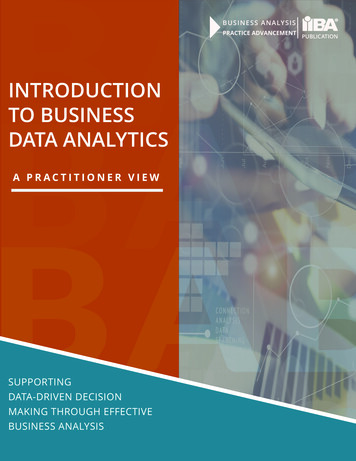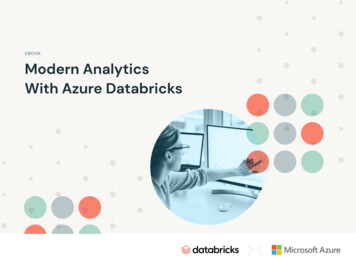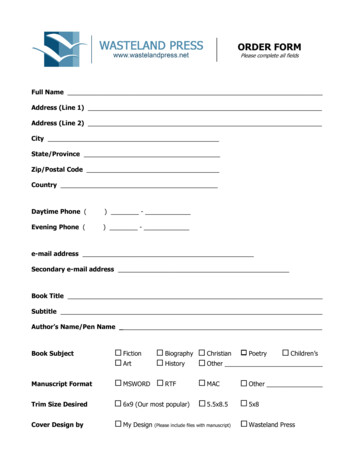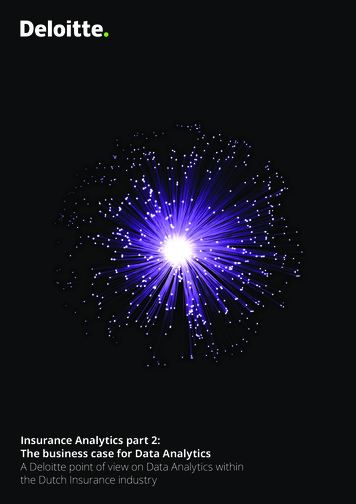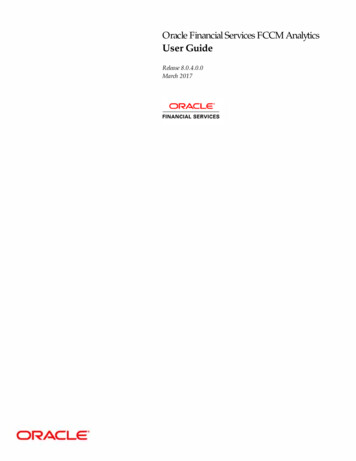
Transcription
Learn Business Analytics in 1 DayBy Krishna RungtaCopyright 2019 - All Rights Reserved – Krishna RungtaALL RIGHTS RESERVED. No part of this publication may be reproduced ortransmitted in any form whatsoever, electronic, or mechanical, includingphotocopying, recording, or by any informational storage or retrievalsystem without express written, dated and signed permission from theauthor.
Table Of ContentChapter 1: What is Business Analysis? Process & Techniques1.2.3.4.What is Business analysis?Why use Business analysis?Steps involved in Business Analysis ProcessCommon Business Analysis TechniquesChapter 2: What is Business Analyst? Roles, Responsibility, Skills,Certifications1.2.3.4.5.Who is a Business Analyst?Different Business Analyst RoleSkills of a Good Business AnalystCertificationsJobsChapter 3: EXAMPLE of Stakeholder Analysis & Mapping with Template1.2.3.4.5.When Stakeholder Analysis need to be done?Stakeholders CategorizationProcess for Stakeholder AnalysisImportant questions to ask during Stakeholder Analysis MappingTips to manage your StakeholdersChapter 4: What is V Model in Software Testing? Learn with SDLC & STLCExample1. EXAMPLE To Understand the V Model2. Problem with the Waterfall Model3. Solution: The V Model
Chapter 5: Requirement Life Cycle Management1.2.3.4.5.What is Lifecycle of Requirement?Phase 1: Requirement DefinitionPhase 2: Requirement ValidationPhase 3: Requirement DocumentationPhase 4: Requirement ManagementChapter 6: What is Waterfall Model in SDLC? Advantages & DisadvantagesChapter 7: What is RAD Model? Advantages & Disadvantages1. Different phases of RAD model includes2. When to use RAD Methodology?3. Advantages and Disadvantages of SDLC RAD ModelChapter 8: Incremental Model in SDLC: Use, Advantage & Disadvantage1. Characteristics of an Incremental module includes2. When to use Incremental models?3. Advantages and Disadvantages of Incremental ModelChapter 9: What is Spiral Model? When to Use? Advantages &Disadvantages1. What is Spiral Model?2. Spiral Model Phases3. When to use Spiral Methodology?Chapter 10: Agile Methodology & Model: Guide for Software Development& Testing1. What is Agile Methodology?2. Agile Vs Waterfall Method3. Scrum
4.5.6.7.8.9.10.11.12.13.14.Product BacklogScrum PracticesProcess flow of Scrum Methodologies:eXtreme Programming (XP)Phases of eXtreme programming:Crystal MethodologiesDynamic Software Development Method (DSDM)Feature Driven Development (FDD)Lean Software DevelopmentKanbanAgile metrics:Chapter 11: Software Requirements Analysis with ExampleChapter 12: Requirements Analysis Techniques with Example: CompleteTutorialChapter 13: What is a Functional Requirement? Specification, Types,EXAMPLES1. What is the Requirement?2. What is a Functional Requirement?3. What should be included in the Functional RequirementsDocument?4.5.6.7.8.Benefits of Functional RequirementExample of Functional RequirementsNon Functional vs. Functional RequirementsBest practice of Functional RequirementMistakes While Creating a Functional Requirement
Chapter 14: What is Non-Functional Requirement? Types and Examples1.2.3.4.5.6.What is Non-Functional Requirement?Types of Non-functional RequirementExamples of Non-functional requirementsFunctional vs Non Functional RequirementsAdvantages of Non-Functional RequirementDisadvantages of Non-functional requirementChapter 15: Functional Requirements vs Non Functional Requirements: KeyDifferences1.2.3.4.5.6.7.What is a Functional Requirement?What is Non-Functional Requirement?Example of Functional RequirementsExamples of Non-functional requirementsFunctional vs Non Functional RequirementsAdvantages of Functional RequirementAdvantages of Non-Functional RequirementChapter 16: How to organize Requirements as a Business Analyst1. How to organize and present a business requirement2. Useful tips for presenting requirementsChapter 17: Change Control Process in Software Engineering with Steps1.2.3.4.5.6.7.What is Change Control?Why Change Control?Different factors of Change Control processProcess of Change ControlChange Process Flow-DiagramSteps for Change ControlChange Management Vs Change Control
Chapter 18: BRS vs SRS: Know the DifferenceChapter 19: What is Software Testing? Introduction, Definition, Basics &Types1. Why is Software Testing Important?2. Types of Software TestingChapter 20: Manual Testing Tutorial for Beginners: Concepts, Types, Tool1.2.3.4.5.6.Goal of Manual TestingTypes of Manual Testing:How to perform Manual TestingMyths of Manual TestingManual Testing vs Automation TestingTools to Automate Manual TestingChapter 21: Defect/Bug Life Cycle in Software TestingChapter 22: What is User Acceptance Testing (UAT)? with Examples1.2.3.4.5.6.7.8.9.Who Performs UAT?Need of User Acceptance Testing:Acceptance Testing and V-ModelHow to do UAT TestingExit criteria for UAT:Qualities of UAT Testers:Best Practices:UAT ToolsSome Example Guidelines of UATChapter 23: Impact Analysis in Software TestingChapter 24: Business Analysis Process: Step by Step Tutorial
Chapter 25: What is ER Modeling? Learn with Example1.2.3.4.5.What is ER Modeling?Enhanced Entity Relationship (EER) ModelWhy use ER Model?Entities in the ""MyFlix"" libraryDefining the relationships among entitiesChapter 26: Decision Table Testing: Learn with Example1. What is Decision Table Testing?2. Example 1: How to make Decision Base Table for Login Screen3. Example 2: How to make Decision Table for Upload Screen4. Why is Decision Table Testing is important?5. Advantages of Decision Table Testing6. Disadvantages of Decision Table TestingChapter 27: What is Static Testing? What is a Testing Review?1.2.3.4.5.6.7.What is Testing Review?Why Static Testing?What is Tested in Static TestingHow Static Testing is PerformedStatic Testing TechniquesTools used for Static TestingTips for Successful Static Testing ProcessChapter 28: Software Configuration Management in Software Engineering1.2.3.4.5.6.What is Software Configuration Management?Why do we need Configuration management?Tasks in SCM processConfiguration Identification:Baseline:Change Control:
7.8.9.10.11.Configuration Status Accounting:Configuration Audits and Reviews:Participant of SCM process:Software Configuration Management PlanSoftware Configuration Management ToolsChapter 29: Microsoft VISIO Tutorial: History, File Types1.2.3.4.5.6.7.8.9.10.What is Microsoft Visio?History of Microsoft VisioVisio File TypesDownload and Install VisioImportant components of VisioHow to use Microsoft VisioApplications of Microsoft VisioBest practices of using Microsoft VisioBenefits of Microsoft VisioDisadvantages of VisioChapter 30: Drools Tutorial: Architecture, Rules Engine EXAMPLES1.2.3.4.5.6.7.8.9.10.11.What is Drool?What is Rule?What is the Rule Engine?Drools Tools SuiteImportant components in DroolsArchitecture of DroolsFeatures of DroolHow to add Drools plugins in EclipseCreate a Drools ProgramWhy use Drools Rule Engine?Disadvantages of Rules Engine
Chapter 1: What is Business Analysis?Process & TechniquesWhat is Business analysis?Business analysis defined as a research discipline that helps you to find thebusiness needs and defining solutions to business problems. It also includesa software-systems development component.Business Analysis process offers concepts and insights into thedevelopment of the initial framework for any project. It stores the key toguide stakeholders of a project who performs business modeling in anorderly manner.Why use Business analysis?Here are important reasons for using Business analysis methods:It helps you to understand the structure and the dynamics of thecompanyIt allows you to understand current problems in the target organization.It helps you to identify improvement potentials and recommendingsolutions to enable an organization to achieve goals.It helps you to identify and articulate the need for change.To maximize the value delivered by an organization to its stakeholders.Steps involved in Business Analysis Process
Here are the steps for Business Analysis:1.2.3.4.5.6.Enterprise analysisRequirement planning and ManagementRequirement ElicitationRequirement analysis and DocumentationRequirement CommunicationSolution Evolution and Validation.Step 1) Enterprise Analysis
This area covers a collection of pre-project activities that leads to up toproject selection guided by the Business Analyst.The activities are as follows:It helps to maintain Business ArchitectureAllows you to prepare the Business CasePreparing for Decision PackageStep 2) Requirement Planning & ManagementIn this step, you need to define the tasks and resource which are associatedwith the planning and management of requirements. This helps you to ensurethat the set of activities that are undertaken is appropriate according to thespecific project. It is also important to capture changes correctly andconsistently.Step 3) Requirement ElicitationThe requirement elicitation phase consists of researching and discovering therequirements of a system from users, customers, and other stakeholders.Step 4) Requirements Analysis & DocumentationThis stage describes how stakeholder needs to analyse, structure, and specifythe design and implementation of a solution. Requirements analysis helpsyou define the methods and tools used to structure the raw data.Step 5) Requirements CommunicationThis phase is the collection of activities for expressing the output of therequirement analysis. Moreover, every requirement needs to be packaged,evaluated, and approved before the solution is implemented.
Step 6) Solution Evaluation and ValidationThis phase ensures that a solution should able to meets thestakeholder objectives.Common Business Analysis TechniquesHere are the most important business analysis techniques:
MOSTMost is a short form of Mission, Objectives, Strategies. It allows businessanalysts to perform thorough internal analysis of what is the aim of anorganization to achieve and how to tackles such issues.PESTLEPestle stands for (Political, Economic, Sociological, Technological, Legal, andEnvironmental). This model helps business analysts to evaluate all theexternal factors which can possibly impression their organization anddetermine how to address them.SWOTSWOT is a full form of Strengths, Weaknesses, Opportunities, and Threats.This technique helps you to find areas of both strength and weakness. It alsoallows for the proper allocation of resources.MoSCoWMust or Should, Could or Would process is a long-form of MosCow. Thistechnique allows prioritization of requirements by presenting a frameworkin which every individual requirement should be evaluated relative to theothers.CATWOECATWOE is an acronym for Customers, Actors, Transformation Process,World View, Owner, and Environmental. This technique helps you torecognize processes that may be affected by any action the businessundertakes.
The 5 WhysThis technique is a backbone of both Six Sigma and business analysistechniques. It consists of leading questions that allow business analysts tosingle out the root cause of an issue by asking why such a situation arises.Six Thinking HatsThis process helps you to consider alternate perspectives and ideas. The 'sixhats' in a technique which his categorized as:Green (creative thinking)Blue talk about big-picture overview. White(logical, data-driven thinking)Yellow (positive thinking, which mainly focused on pros) Red(emotion-based reactions)Black (opposing thinking, which is focused on cons)Summary:Business analysis is a research discipline that helps you to find thebusiness needs and defining solutions to business problemsIt helps you to understand the structure and the dynamics of thecompanyHere are the steps for Business Analysis: 1) Enterprise analysis 2)Requirement planning and Management 3) Requirement Elicitation 4)Requirement analysis and Documentation 5) RequirementCommunication and 6) Solution Evolution and Validation.
Important business analysis techniques are: 1) MOST 2) PESTLE3) SWOT 4) MoSCoW 5) CATWOE 6) The 5 Whys and, 7) Six Thinking HatsMost is a short form of Mission, Objectives, StrategiesSWOT is a full form of Strengths, Weaknesses, Opportunities, andThreatsMust or Should, Could or Would process is a long-form of MosCowCATWOE is an acronym for Customers, Actors, Transformation Process,World View, Owner, and EnvironmentalThis technique is a backbone of both Six Sigma and business analysistechniquesThis process helps you to consider alternate perspectives and ideas
Chapter 2: What is Business Analyst?Roles, Responsibility, Skills,CertificationsWho is a Business Analyst?Business Analysts have emerged to have a key role in recent businessscenarios. Some people think that the role of a Business Analyst is to makemoney for the organization, which may not be true in direct context. Butindirectly, the action and decision taken by Business Analysts do leave animpact on the financial prospects of the organization.What does a Business Analyst Do?A primary job responsibility of Business Analyst is to communicate with allstakeholders & to elicit, analyze and validate the requirements for changesto business processes, information systems, and policies.A professional business analyst plays a big role in moving an organizationtoward efficiency, productivity, and profitability.Before we jump into the tutorial, we will see some basic perspective of aBusiness Analyst to help the organization succeed. The foremost priority forany business analyst will be to try understanding following things
Understand what business does and how it does Determinehow to improve existing business processesIdentify the steps or tasks to support the implementation of newfeaturesDesign the new features to implementAnalyze the impact of implementing new features Implementthe new featuresDifferent Business Analyst RoleBusiness Analyst can be from any sector, and the role differs based on thesector. Business Analyst are classified into various categories likeBusiness Analyst BusinessProcess Analyst IT BusinessAnalyst Business SystemAnalyst System AnalystData Analyst FunctionalArchitect Usability or UXAnalystSkills of a Good Business AnalystBasically, a good business analyst is judged on these four attributes
Analytical skills- An outstanding analytical skills will separate out a goodbusiness analyst. A good part of BA role includes analyzing data,workflow, user or stakeholders inputs, documents, etc.Leadership skills- directing team members, forecasting budget, helpingteam members with the problem, etc.Business process and planning- Planning the project scope,understanding and implementing requirement of project, identifyingresources required for the project and so on Technical skill- If abusiness analyst is in the IT sector, few technical aspect are expectedto know like operating systems, hardware capabilities, databaseconcepts, networking, SDLC methodology, etc.CertificationsAs per the International Institute of Business Analysis (IIBA), CBAP (CertifiedBusiness Analysis Professional) certification is a recognized certificate for aprofessional Business Analyst. They provide two types of certifications. Thecertification exam is computer based and consists of multiple choicequestions.
Certification of Competency in Business Analysis: Pre-requisite for thiscertification is atleast 3750 hours of work experience Certified BusinessAnalysis Profession (senior level): Pre-requisite for this certification isatleast 7500 hours of work experienceFor off-shore students, they can appear certification exam online. For moreinformation, you can visit the website.JobsJob prospectus for Business Analyst rises every year, especially for the ITsector. The average salary of business analyst is estimated around 80,000 - 130, 000, even at entry level.International Institute of Business Analysis (IIBA) is growing exponentiallyindicating increasing demand of Business Analyst. Business Analyst alwaysremain an organization priority since they have to work in a close proximityto top executives, clients, and stakeholders.According to U.S Bureau of Labor Statistics, the BA job are predicted toincrease by 19% between 2012 and 2022.Conclusion:The business analyst role is promising and has to deal with differentlayers of an organization. Business analyst are classified into variouscategories like Business Process Analyst, IT Business Analyst and so on.A good business analyst should encompass skills like
Analytical skillsLeadership skillsBusiness process and PlanningTechnical SkillsVarious tools that can help Business Analyst are TopTeam Analyst,SmartDraw, Blueprint, etc.Online certification course for BA available by recognized institute IIBAAccording to U.S Bureau of Labor Statistics, the BA job are predicted toincrease by 19% between 2012 and 2022.
Business analysis is a research discipline that helps you to find the business needs and defining solutions to business problems It helps you to understand the structure and the dynamics of the company Here are the steps for Business Analysis: 1) Enterprise analysis 2) Requirem

